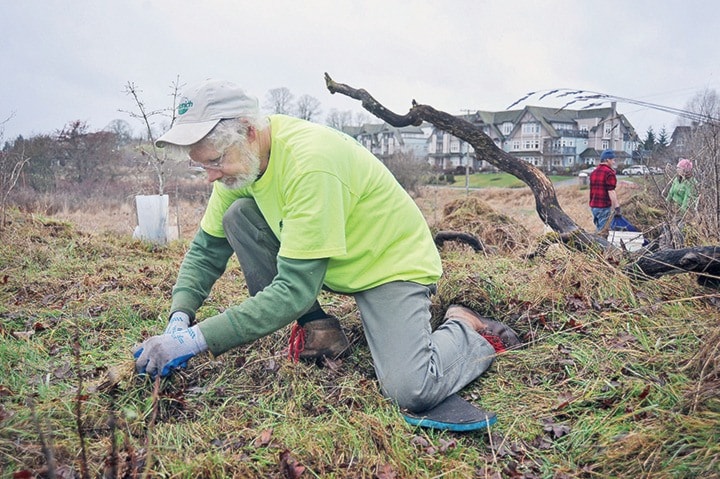Decades ago, long before suburban development in Royal Oak, it seemed a bright idea to plant reed canary grass for cow feed on farmland around Rithet’s Bog.
While not exactly cursing that era, Russ Pym and other volunteers now spend their weekends yanking the invasive species from the ground. Reed canary grass grows fast and tall, monopolizing nutrients and shading out competing native plants. Bringing 42-hectare Rithet’s Bog to a roughly natural state is a labour of love that will take years.
“Early volunteers cleared a lot of broom, and reed canary grass moved into the area. It is a major invasive species,” said Pym, president of the Rithet’s Bog Conservation Society and a retired biologist. “Because it was used for agriculture, its seeds were prolifically spread. It grows waist-high and shades out the native plants.”
“Reed canary grows into the wetland, it terrestrializes the edge and creeps in. We know that is happening at the south end where we have a shallow fen. Willow is starting to creep in. It’s native but we want to keep it from taking right over.”
A small band of Rithet’s volunteers have been clearing a Garry oak meadow of the invasive grass for about six months. Restoring Garry oak meadows is a preoccupation of conservation groups across Greater Victoria, and this meadow lies at the entrance to the park.
“Because it’s a Garry oak site and because it’s dry, we can work through the winter. It’s at the entrance to the park and is noticeable and help attracts volunteers,” Pym said.
Like most environmental stewardship groups in Saanich, Rithet’s volunteers can only cut, pull and haul so much invasive biomass. Pym said restoration success is directly related to the number of volunteers, usually four to eight in a work party.
For Pym, the wetland is worth the effort. It’s home to more than 100 bird species, dozens of dragonfly and butterfly species, endangered frogs and plenty of deer, like most everywhere else in the region. Working in the bog allows him to continue as a biologist and a nature watcher.
“It’s something I’ve done all my life, and it allows me to get outdoors into an enjoyable place,” he said. “I like watching the birds and dragonflies and seeing the native plants.”
Progress to eradicate invasives has been slow but steady, and has seen results. Volunteers have cut back non-native cattails, a species that overgrows the wetland faster than it can be controlled through natural means. Pym said volunteers have worked hard for years to cut channels through cattails to the pond.
“You don’t select individual plants, you just clear out large areas, about 500 metres squared. It is a big pile of cattails,” he said. “We’ll need to keeping doing the cattail project for five to seven years. It will probably be a 10-year project.
“It’s not insurmountable. Before it was park there was a lot of broom and people thought (removing) that was insurmountable,” Pym said. “You can’t force native species into the area, but we’re just trying to create the environmental system so they can grow in that site, so it will look after itself.”
See rithetsbog.org for information on volunteering.
editor@saanichnews.com
